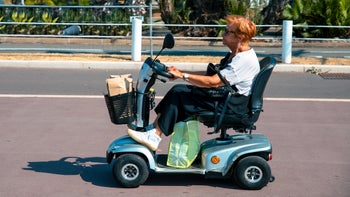
Does Medicare Cover Canes?
Key takeaways:
Original Medicare’s Part B and Medicare Advantage plans cover canes if you have a prescription from a doctor or other healthcare professional.
Once you meet your Part B deductible, Medicare will pay 80% of the approved cost of a cane. You are responsible for the other 20%. Your cost-sharing may be different with Medicare Advantage.
Medicare covers many types of canes, including standard or single-point, quad, and folding.

This guide explains how original Medicare and Medicare Advantage plans cover canes and walking sticks. Canes are among the walking aids that can be game-changers for Medicare enrollees seeking improved mobility and independence.
Does Medicare cover canes?
Yes. Original Medicare’s Part B and Medicare Advantage plans cover canes and walking sticks when:
The mobility aid is deemed medically necessary for you.
You have a prescription from your doctor or treating healthcare professional for the type of cane required.
You obtain the cane from a Medicare-approved supplier.
Prescription Savings Are Just the Beginning
See what other benefits you qualify for—from cashback cards to cheaper insurance.

Part B and Medicare Advantage plans cover many items classified as durable medical equipment (DME). DME includes reusable mobility aids that are medically necessary.
Your doctor will refer you to an approved supplier, but you can also search for one using the Medicare DME supplier search tool or by calling 1-800-MEDICARE (800-633-4227) for help. Common DME, such as canes, may be covered and available at your local pharmacy, so you may not need to visit a medical supply store.
Medicare does not cover used DME. Your covered cane will be a new device. Medicare also covers manual and power wheelchairs, as well as power scooters used in the home. But mobility home improvements, such as stair lifts, are not covered.
How much does Medicare pay for a cane?
After you meet your Part B deductible, Medicare covers 80% of the approved cost for DME, including canes. You are responsible for the remaining 20%.
Because the Part B deductible in 2024 is $240, you may end up paying the full price of your cane if you haven’t had much medical care in a calendar year. That’s because many covered canes and walking sticks cost less than $100. If you’ve already met your deductible, you would pay the 20% coinsurance.
The Medicare DME supplier directory lets you compare cane suppliers in or near your ZIP code to determine if they are participating providers that will accept assignment, which means they will take the Medicare-approved amount for an item as full payment. They also file the claim for Medicare to pay its share and usually wait to bill you for your part of the cost.
Canes act as a third foot on the ground. Canes give you stability by preventing falls, easing pain, and helping you avoid or delay the loss of mobility.
If you need a wheelchair, that’s covered, too. Medicare and Medicare Advantage plans also cover manual and power wheelchairs.
You may be able to get a free cane. You may be able to get a new or secondhand cane at no cost from a medical equipment loan program near you.
A non-participating provider may or may not accept assignment, which means they can bill for more than the Medicare-approved amount, so you may pay more than your 20% coinsurance.
If they are not a Medicare-approved supplier or they don’t accept assignment, you may be asked to pay up front — and in full — for your cane, and it will not be covered by your Medicare plan.
What types of canes does Medicare cover?
Medicare covers most types of canes, as long as your doctor or healthcare professional writes a prescription and you buy the walking aid from an approved DME supplier. Canes can be made of wood, aluminum, steel, or other materials. All must have rubber tips on the end. Some have hand grips. They come with a fixed height or an adjustable-height feature. Any type of cane can have designs or embellishments and also may be classified as a “fashion” cane.
Read more like this
Explore these related articles, suggested for readers like you.
The types of canes Medicare covers include:
Standard canes and walking sticks: Standard canes are single-point models designed for general stability and balance. They typically have a curved handle, known as a J-hook. They are ideal for people who need minimal support and want a traditional, lightweight, and easy-to-use option.
Quad canes: Quad canes have four prongs at the base for added stability. They are useful if you need additional support and balance assistance. They are a popular choice for people who not only need stability and balance, but also have mobility issues.
Offset canes: Offset canes have handles with a pronounced curve that offer a more comfortable and ergonomic grip. They also often have a hand grip. The design helps distribute weight more evenly, which reduces strain on your wrists and makes the cane easier to use for extended periods.
Seat canes: Also known as cane seats, these devices combine the utility of a cane with a small, foldable seat. This allows users to take a quick rest when needed. This type is perfect for individuals who tire easily or who need frequent breaks while walking.
Folding canes: Folding canes are perfect for people who may not always need the added support of a cane, but want to have one on hand just in case. You can retract and stow them when not in use.
Does Medicare cover canes for the blind?
No. Medicare’s walking aids coverage does not cover white canes for the blind.
How does Medicare’s durable medical equipment (DME) benefit work?
Medicare’s durable medical equipment (DME) benefit covers items that are long-lasting, medically necessary, and suitable for use at home. This includes some mobility devices, including canes, wheelchairs and power scooters.
To get a Medicare-covered cane, follow these steps:
Schedule an appointment and meet with your doctor about your mobility needs.
Your doctor will write you a prescription if they determine that a cane is medically necessary for you.
Buy your cane from a Medicare-approved supplier.
Typically, the supplier will bill Medicare directly, and you’ll be responsible for your share of the cost.
Frequently asked questions
Canes are the most simple type of walking aid. They provide a third point of contact with the ground that helps improve your balance and keep you on your feet. They can prevent falls, ease joint and muscle pain, and help with daily activities.
White canes are mobility aids for those who are visually impaired. A white cane for a blind person is considered a self-help device by Medicare and not a treatment for illness or injury.
Stair lifts are considered home modifications and not durable medical equipment by Medicare. That means the mobility aids — also known as stair elevators — are not covered.
Medicare Part B and Medicare Advantage plans cover canes as part of the durable medical equipment benefit when you have a doctor’s prescription. After you meet your Part B deductible, Medicare covers 80% of the cost of your cane if it’s obtained by a Medicare-approved supplier. You pay the other 20% and any excess charges beyond the Medicare-approved amount. Various types of canes — including single-point, quad, and offset — are covered.
Why trust our experts?



References
Center for Medicare Advocacy. (2021). Beneficiary guide: Medicare coverage for
Centers for Medicare & Medicaid Services. (2020). Canes and crutches.
Centers for Medicare & Medicaid Services. (2022). Canes and crutches - policy article.
Health in Aging Foundation. (2019). Tip sheet: Choosing the right cane or walker. American Geriatrics Society.
Medicare.gov. (n.d.). Canes.
Medicare.gov. (n.d.). Costs.
Medicare.gov. (n.d.). Does your provider accept Medicare as full payment?
Medicare Interactive. (n.d.). Participating, non-participating, and opt-out providers.





























